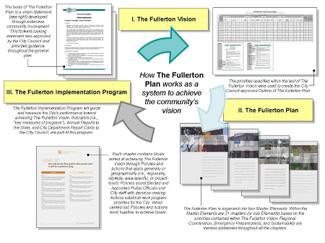
Reinventing the General Plan
A Project of the California Planning Roundtable
With support from the American Planning Association, California Chapter
Great Model: City of Fullerton
Featured Principles: Create a Vision, Look Beyond Local Boundaries, Be Universally Attainable
- Context
- The Vision Drove the Plan
- Focus on Implementation and Usability
- Connecting Local to Global
- Challenges and Lessons Learned
- Background Information
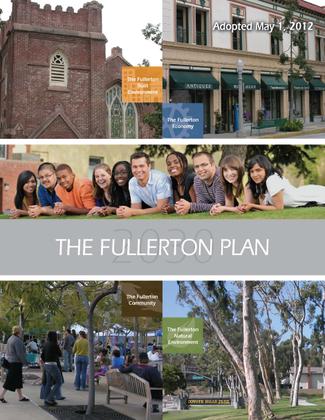
The Fullerton Plan is both driven by vision and grounded in implementation. The Fullerton Plan is a big picture, user-friendly plan designed to achieve the community’s collective vision for the future, while being fiscally responsible and sensitive to competing demands.
The Fullerton Plan serves as the City of Fullerton’s General Plan pursuant to State law, but goes beyond California’s legal requirements. The Fullerton Plan serves as a governance tool to achieve a defined vision by aligning City efforts, reaching out to partners in Fullerton and the region, and engaging the Fullerton community.
The Fullerton Plan began with a community education and visioning process in 2007, and was adopted on May 1, 2012. Over the 5-year process, an economic downturn, changes in key staff, challenging social issues, and community demands for leadership changes shaped the plan development.
A few of the distinguishing features of The Fullerton Plan are:
-
Community Vision Driven. Everything in The Fullerton Plan, from the 20 topical sub-Elements to policies for 12 Focus Areas, was developed to respond to the Plan’s Vision.
-
Placemaking over Land Use Planning. Whereas most General Plans emphasize the Land Use Element, the Fullerton Plan does not include a Land Use changes and instead uses keys themes as its outline, with a focus on placemaking rather than land use planning. The Vision statement of the Plan identifies objectives for each Focus Area, and the Plan defers land use changes to subsequent planning processes. This approach allowed the City to both focus on larger issues important to the community and produce a streamlined, succinct plan. This approach also had political advantages, by leaving detailed land use decisions for later planning projects.
-
Focus on Implementation and Usability. The Fullerton Plan is succinct, action-oriented, and user friendly. The heart of the document – the policy program – was intentionally crafted to be straightforward and streamlined. A User’s Guide provides instruction on how to use the Plan. A Short-Term Action Plan and Implementation Process spell out specific “next steps” to achieve goals and monitor progress over time.
-
Connecting Local to Global. While many local planning documents focus on internal challenges and opportunities, The Fullerton Plan provides policy guidance for different levels of geography – from the region and subregion down to project level.
Click here to view The Fullerton Plan: http://www.ci.fullerton.ca.us/depts/dev_serv/general_plan_update/default.asp
The strength of The Fullerton Vision is that it forms the basis for the whole of The Fullerton Plan, from the 20 topical sub-Elements to policy guidance for the 12 Focus Areas. The Fullerton Vision is a statement of what Fullerton hopes to maintain and become through the implementation of The Fullerton Plan. The Vision provides a sense of purpose and mission, and sets the tone for The Fullerton Plan’s goals, policies and actions. The Fullerton Vision establishes a community-based foundation which captures the qualities, values, and characteristics of the City of Fullerton now and in the future. The Vision was developed through extensive community participation activities, including visioning charrettes, neighborhood meetings, “roadshow” presentations, and meetings with the General Plan Advisory Committee.
The outline for The Fullerton Plan document was developed based on the key themes that emerged through the visioning process and are expressed in The Fullerton Vision. For example, The Fullerton Vision states “Fullerton will be a city which… encourages civic participation by the full spectrum of its community and reflects its concerns in official planning and decision-making.” The Community Involvement Sub-Element of The Fullerton Plan directly reflects this aspiration.
Each sub-Element of the Plan begins with a quote from The Fullerton Vision, reminding the reader of the tie back to the overall community statement. As each goal and policy was crafted, City staff and the consultant constantly referred back to the community’s vision to ensure the language used reflected Fullerton’s aspirations. For example, Goal 10 in The Fullerton Plan is “An innovation economy built upon Fullerton’s local entrepreneurial spirit and intellectual capital.” One policy under this goal is “Economic Gardening Pilot Program. Support programs to encourage Fullerton residents to become entrepreneurs and invest in new businesses with high growth potential.” Both the goal and policy are tied back to a section of The Fullerton Vision which describes Fullerton as a city which “enjoys a vibrant economy, benefiting from its education community resources and diverse business base, encourages economic diversity and creation of new jobs…” The policy articulates how Fullerton can harness existing intellectual capital to increase economic diversity and expansion.
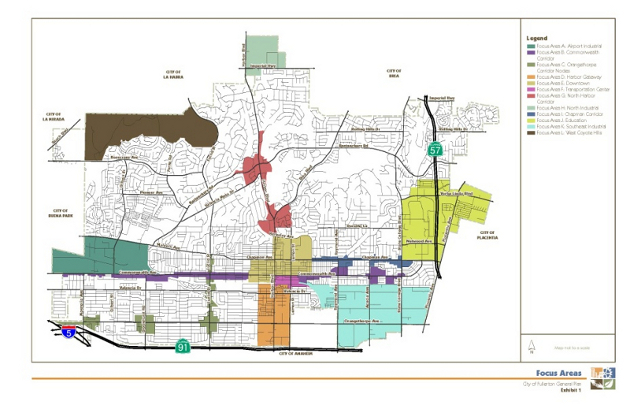
Whereas many General Plans place an emphasis on Land Use changes, the Fullerton Plan does not make detailed land use changes. The City deferred land use decision making to subsequent planning processes, and designed the Fullerton Plan to plan for Focus Areas and provide policies for key characteristics and activities in those focus areas that are important to the community. The Fullerton Vision identifies Focus Areas and sets forth objectives for each Focus Area. The placement of the focus areas within the Vision section illustrates how The Fullerton Plan emphasizes that Focus Areas are not just identified for land use change. In many ways, the Fullerton Focus Areas are the geographic representation of The Fullerton Vision. The Focus Areas tie the broad aspirations of the community to specifics on the ground. The Planning Objectives stated for each Focus Area encompass aspects of The Fullerton Vision, such as opportunities for economic development activities, preservation and enhancement of historic, cultural and natural resources, expanding community access and increasing mobility, and placemaking.
For example, the Southeast Industrial Focus Area is envisioned to grow as Fullerton’s industrial base. The Planning Objectives expand the future potential of the Focus Area to include “amenities and services that will support the work force, such as recreation, retail, and limited housing opportunities” and “improve the appearance and function through design, including landscaping, pedestrian and transit facilities.” These Planning Objectives reflect The Fullerton Vision that describes Fullerton as a city which “has an increasing choice of accessible, affordable and desirable housing options,” “offers a variety of transportation options,” and “supports community health.”
While the Focus Areas provide guidance for future land use change, the land use policy was not actually changed from the previous General Plan to The Fullerton Plan. This decision allowed the City to not grapple with land use details at the General Plan policy level, garnering a high level of political support for the Plan. In doing so, the City was able to save time and money in developing the General Plan, while allowing subsequent community-based planning processes to further support the vision. The Fullerton Focus Areas establish objectives and provide guidance for future specific plans or area plans, and these areas will be planned for in more detail through future planning processes. The choice to address the Focus Areas on a broader policy level within The Fullerton Plan is consistent with the focus on “big picture” issues throughout The Fullerton Plan. The choice allowed the City to focus more on all the aspects of placemaking within the Focus Areas and less on the details of density and intensity, and will allow the City to be flexible in the future as different opportunities for change or growth in these areas arise.
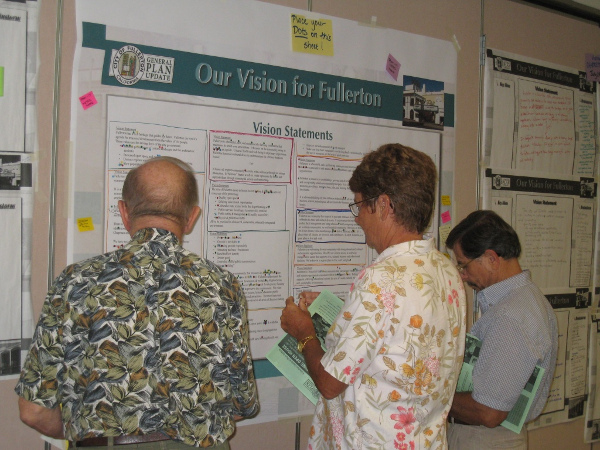
http://www.ci.fullerton.ca.us/civicax/filebank/blobdload.aspx?blobid=7501
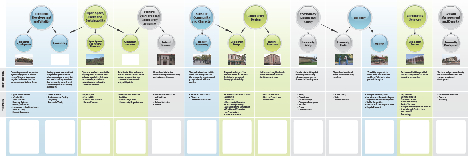
Theme Chart Used with GPAC to Move from Vision to Element Outline
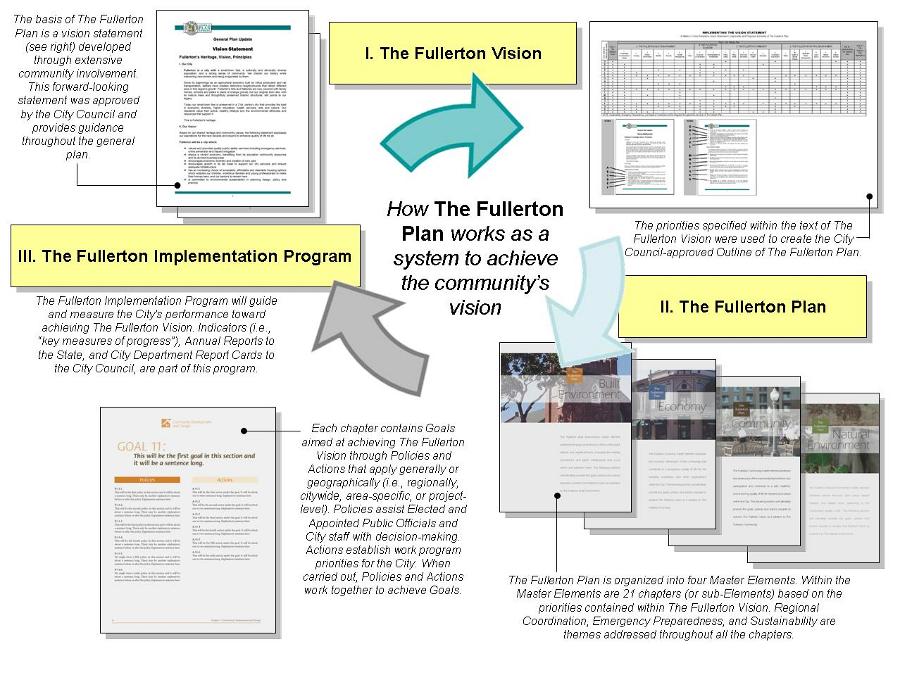
Too often, planning documents sit on shelves at City Hall, seldom used by staff and decision makers. Fullerton’s previous General Plan fell into this unfortunate category. City staff outside of the Community Development Department rarely referenced the General Plan; some had never opened it or did not know it existed. Up until just a couple of years ago, General Plan consistency was not even included in staff reports to the Planning Commission and City Council.
Within The Fullerton Plan, the City built in specific components that ensure this plan will not be one that sits on the shelf. The City focused on building in a strong implementation program and process, coupled with deliberate steps to make the document appealing to the user.
The Fullerton Plan begins with a User’s Guide – an 11x17 simple chart where the user can find his or her role at the top (i.e. City staff, property owner, elected/appointed official, etc.). Below each role, the User’s Guide describes the sections most relevant to the user and guides him/her in some basic steps to using the document. This User’s Guide helps orient the new user, and also reinforces the role of each person in implementing The Fullerton Plan.
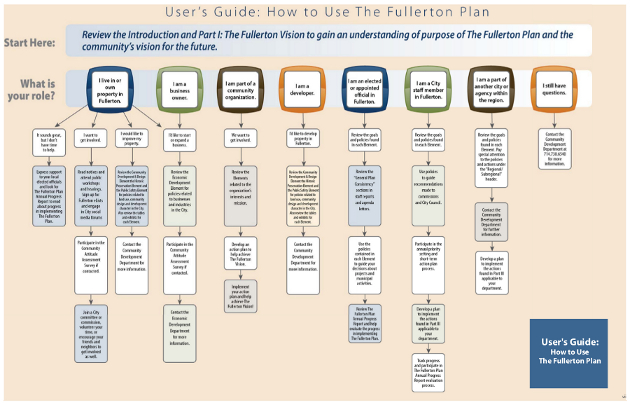
Source: http://www.ci.fullerton.ca.us/civicax/filebank/blobdload.aspx?blobid=7498
The Fullerton Plan Implementation Strategy is the City’s guide for implementing the policy program and achieving the goals within The Fullerton Plan. The City developed a 4-step implementation process that ties key City functions, including annual City Council priority setting, budgeting, tracking, and reporting, to The Fullerton Plan. All of the departments – not just Community Development – will refer to the goals and policies, and most importantly to the short term action plan when budgeting for department activities on an annual basis. The City went so far as to integrate expectations of demonstrated awareness and understanding of The Fullerton Plan into annual senior staff performance reviews. Each Supervisor is expected to uphold the intent and participate in the implementation of The Fullerton Plan.
The Program EIR is the companion document to The Fullerton Plan that focuses on implementation from the perspective of CEQA clearance. While The Fullerton Plan did not change the land use map from the previous General Plan, an anticipated land use change was analyzed in the Program EIR, providing a document off of which future projects can tier. The City is also updating its CEQA guidelines, which will provide future applicants with clear direction on how tiering will occur and mitigation measures will be addressed.
Overall, The Fullerton Plan is small in size, while large in impact. The brevity of the document is intended to make sure reading and using The Fullerton Plan is not a burden. The policy text was deliberately crafted to be concise and the policy portion of the Plan is only 1/4 inches thick, compared to 1-1/4 inches in the previous General Plan.
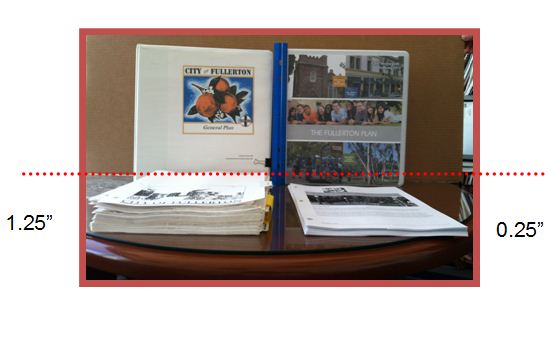
While many General Plans list actions to implement the policy program over 10 to 20 years, The Fullerton Plan only identifies actions to be completed within 3 to 5 years. Subsequent action plans will be established through the City Council priority setting process. Though The Fullerton Vision and The Fullerton Plan goals are long-range, the tools available to implement The Fullerton Plan are going to change over time. For example, The Fullerton Plan was adopted shortly following the dissolution of redevelopment agencies statewide. The City is grappling with developing new funding and financing mechanisms in response to the loss of one of its largest source of funds for a built-out community. It would be premature to commit to implementation programs for which the City could not reasonably anticipate funding. On the flip side, there may be new, creative approaches to community development and local governance over the life of the Plan. The exercise of identifying future actions on a regular basis forces the City to carefully consider new approaches and commit to only those actions most appropriate for the time and that can reasonably be accomplished.
The City will monitor the Plan’s success using phone surveys that will be conducted every other year. The phone surveys will use the community’s views on quality of life as indicators to measure the Plan’s effectiveness. This focus on the community’s sense of their quality of life is different from the more data-driven approach to indicators that many communities use, but it reflects the priorities of the community and local decision makers. This approach was also developed based on the City’s monitoring capacity and does not over-commit City resources to a monitoring procedure beyond available funding and staffing levels.
The Fullerton Implementation Strategy: http://www.ci.fullerton.ca.us/civicax/filebank/blobdload.aspx?blobid=7510
.
While many local planning documents focus on internal challenges and opportunities, The Fullerton Plan also looks outward to Orange County, Southern California, and beyond in order to stay abreast of larger currents affecting Fullerton and to provide leadership in regional matters. The policies within The Fullerton Plan are categorized into four different levels of geography –region/subregion, city, neighborhood/district, and project. These provide guidance to City staff and decision makers as they are reviewing proposals and opportunities at each of the four levels.
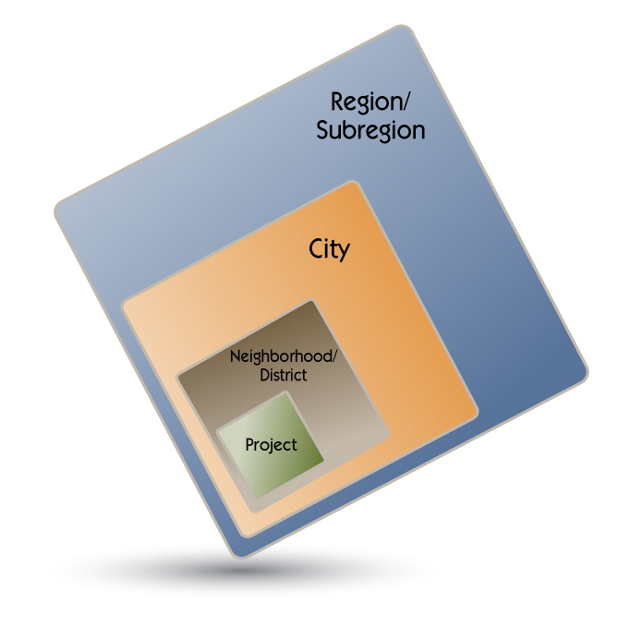
Region/Subregion Level – For matters affecting Fullerton that extend beyond its borders, the City communicates and coordinates with neighboring cities and other jurisdictions in North Orange County, Orange County, or Southern California. The region/subregion level policies focus on supporting these efforts, partnering and coordinating with surrounding jurisdictions, and identifying Fullerton as a leader in regional and subregional issues when appropriate. The policies acknowledge that while Fullerton has control over many things within the City’s boundaries, it does not necessarily have control or responsibility for issues outside its boundaries. This was especially important to the General Plan Advisory Committee and community members who did not want to see the City make the mistake of over-committing itself in realms where it is not necessarily appropriate for the City to be the leader. For example, a region/subregion policy within the Mobility Element is “Reduction of Single Occupant Vehicle Trips. Support regional and subregional efforts to increase alternatives to and infrastructure supporting reduction of single occupant vehicle trips.” This policy recognizes that Fullerton residents do not always start and end their trips within the City limits. Regional transit improvements and policy changes are needed to facilitate the shift from single occupant vehicles. In this policy, the City recognizes its limitations, but also commits to supporting larger efforts for change.
City Level – Within Fullerton’s borders, the City makes decisions within its jurisdiction about activities that affect the public interest, partners with other public agencies and private sector entities, and develops plans, programs, and policies that will be carried out citywide. For example, a city level policy within the Mobility Element of The Fullerton Plan is “Integrated Land Use and Transportation. Support projects, programs, policies and regulations to integrate land use and transportation planning and implementation.” In this city level policy, Fullerton recognizes its key role as the land use authority and its ability to better integrate land use and transportation planning projects within the city boundaries.
Neighborhood/District Level – Districts and Neighborhoods are areas within Fullerton with their own distinct identities within the context of the larger Fullerton community. They lend themselves to the formation of community-based groups that seek to improve or maintain these areas. The City can enhance districts within Fullerton by working with these groups, guiding development, directly making physical improvements, and carrying out programs. At the neighborhood level, the City plays a similar role with an emphasis on maintaining and enhancing neighborhood character. While districts and neighborhoods have their own identities, the individual districts and neighborhoods are interconnected physically, economically, and socially. The City initiates and supports efforts in these areas within the context of the Fullerton community as a whole. For example, a neighborhood/district level policy in the Mobility Element of The Fullerton Plan is “Neighborhood and Focus Area Connections. Support projects, programs, policies and regulations to connect neighborhoods via a multi-modal network to each other and to the City’s Focus Areas.” This policy addresses mobility on at the neighborhood-scale, focusing on connections and internal network.
Project Level – A project is an undertaking that changes the built environment. Often it is an individual proposal for development that the City reviews for compliance with policies and regulations. As part of this review, the City considers the project’s possible environmental impacts, and impacts on public infrastructure such as streets and parks. The City also carries out projects of its own, such as construction of public facilities—sometimes in partnership with a private entity or another public agency such as a school district. An example of a project level policy is “Infrastructure for Low and Zero Emissions Vehicles. Support projects, programs, policies and regulations to encourage the development of private and/or public infrastructure facilitating the use of alternative fuel vehicles.” This policy is one that the City can refer to when reviewing a specific project proposal.
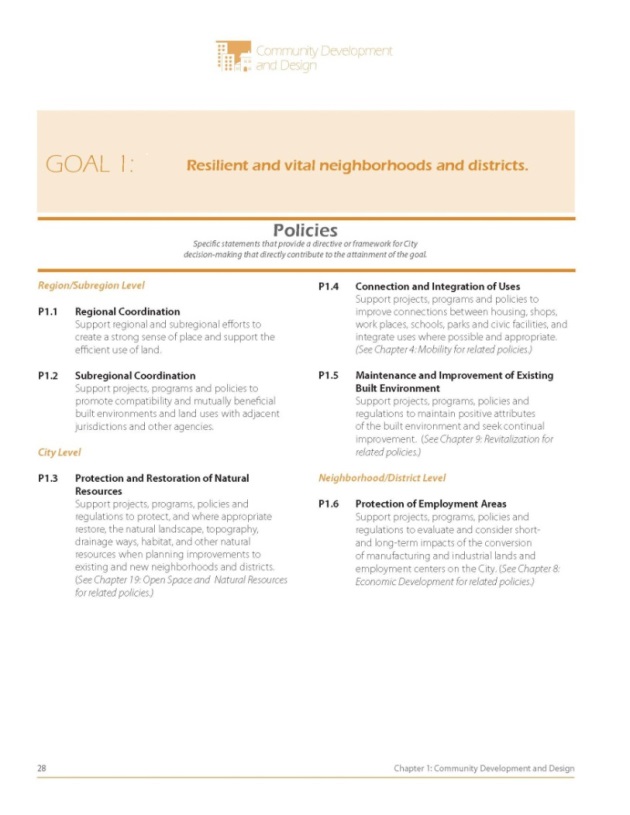
When the City began the General Plan update, the process was anticipated to take between 18 and 24 months. Ultimately, The Fullerton Plan took 5 years to be completed. The length of the process was both a result of some challenges that arose along the way and resulted in additional challenges for the City to weather.
Economic Climate. In 2007, Fullerton’s economy was holding strong and any dips were thought to be temporary. As the subsequent recession hit, the community refocused on being fiscal responsibility and how to utilize scarce financial resources. When the General Plan Advisory Committee (GPAC) began reviewing draft policies in Spring 2011, the message to staff and the consultants was clear – the General Plan should not commit the City to things it cannot do with current financial limitations. Policy language was revised to reflect what the GPAC felt the City could realistically support.
Milestone Approvals. One of the key factors in keeping The Fullerton Plan alive during the five years was the City Council’s review and approval of components of The Plan at key milestones. The City Council approved The Fullerton Vision at the end of the community visioning process. The outline for The Plan was also reviewed and approved by City Council prior to the policy development. These set the foundation for the rest of The Fullerton Plan development. If these key approvals did not occur, after the five years of work, the project team could have been sent back to the drawing board to start from scratch.
Balancing Input. Throughout The Fullerton Plan process, there were a number of voices heard, including those of the GPAC, other elected and appointed officials, outside organizations, and passionate community members. City staff and the consultant team grappled with ongoing questions about the community and stakeholder input into the plan – Were the voices heard representative of the community as a whole? Were there ways to ensure the wide range of views on a number of topics are considered? How much input should the GPAC have in the process versus the final plan? How much is too much? After a two year visioning process, it became apparent that community dialogue about topics included in The Fullerton Plan could go on for years. City staff had to determine when it was time to move forward with developing the actual plan. At this point, a hiatus in GPAC meetings allowed staff and the consultant team to digest the community input and formulate draft goals and policies. This break was found to be very beneficial as it allowed the team to test ideas and strategies before going back to the GPAC with a full set of recommendations to consider. The GPAC was then able to focus on refining and confirming the directions set forth by The Fullerton Plan.
Changes in Project Team Members. During the five-year process, a number of staff changes occurred, both on the consultant team and the City staff team. Continuity was a challenge with varying levels of knowledge about the project and different perspectives on the process. City staff was challenged by the political environment in the city and a key element to the process was identifying the team members that would be the best “faces” of the project- those who understood the technical aspects of the project, but could also work best with the GPAC and other City elected and appointed officials. Ultimately, the process resulted in a General Plan that former and current members of the Project Team could be proud of.
Community Description
Located 22 miles southeast of metropolitan Los Angeles, in the center of North Orange County, Fullerton is renowned for its unique mix of residential, commercial and industrial, educational, and cultural environments which provide an outstanding quality of life for both residents and businesses alike. The following table compares Fullerton’s to its surrounding cities. With over 135,000 residents and over 22 square miles of land, Fullerton is the second largest city in North Orange County. Fullerton is an ethnically diverse community with growing Asian and Hispanic populations, similar to the County as a whole. With a variety of housing and employment opportunities, along with award-winning educational institutions, Fullerton attracts residents with a wide range of interests and needs.
| Fullerton | La Mirada | Buena Park | La Habra | Brea | Placentia | Anaheim | |
| Land Area (sq. miles) | 22.4 | 7.8 | 10.5 | 7.4 | 12.1 | 6.6 | 49.8 |
| Population | 135,161 | 48,527 | 80,530 | 60,239 | 39,282 | 50,533 | 336,265 |
| Median Household Income | $67,632 | $79,954 | $62,139 | $60,927 | $77,524 | $73,088 | $56,496 |
| Median Age | 34.8 | 37.9 | 35.1 | 33.6 | 38.7 | 36 | 32.4 |
| Race/Ethnicity | |||||||
| White | 53.9% | 60.7% | 45.3% | 58.3% | 67.1% | 62.1% | 52.7% |
| Black/African American | 2.3% | 2.3% | 3.8% | 1.7% | 1.4% | 1.8% | 2.8% |
| American Indian/Alaska Native | 0.6% | 0.8% | 1.1% | 0.9% | 0.5% | 0.8% | 0.8% |
| Asian | 22.8% | 17.8% | 26.7% | 9.4% | 18.2% | 14.9% | 14.8% |
| Native Hawaiian/Other Pacific Islander | 0.2% | 0.3% | 0.6% | 0.2% | 0.2% | 0.1% | 0.5% |
| Some Other Race | 15.9% | 13.7% | 17.5% | 25.3% | 8.2% | 16.3% | 24.0% |
| Two or More Races | 4.3% | 4.3% | 5.1% | 4.2% | 4.4% | 4.0% | 4.4% |
| Hispanic/Latino (Any Race) | 34.4% | 39.7% | 39.3% | 57.2% | 25.0% | 36.4% | 52.8% |
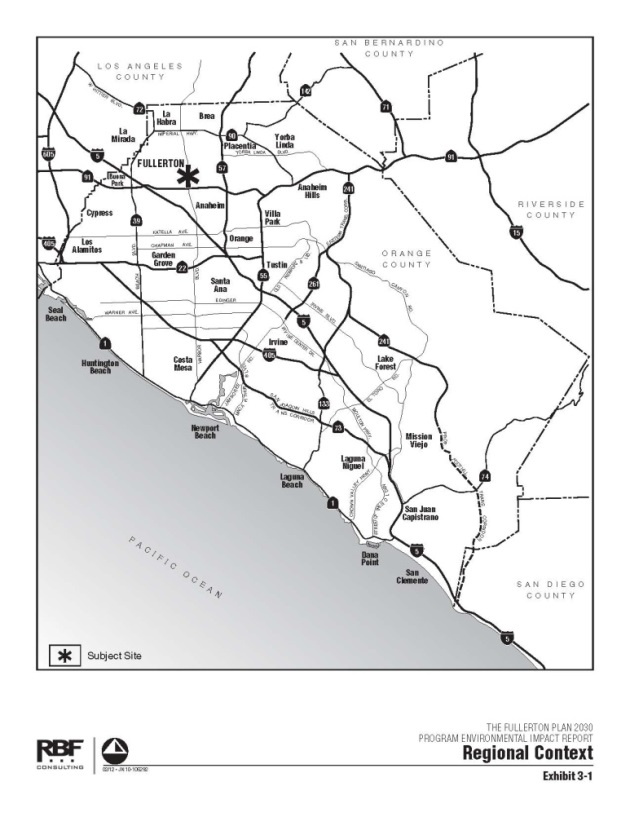
Major industries in the city are education, medical, and professional services. Fullerton is home to six colleges and universities. The major employers in the City include:
- CSU Fullerton
- St. Jude Medical Center
- Raytheon Systems THALES)
- Fullerton School District
- Beckman Coulter
- Fullerton College
- Alcoa Fastening Systems
- Fullerton Joint Union High School District
- St. Jude Heritage Health
Timeframe/Keeping on Track
Development of The Fullerton Plan was initiated in 2007 and completed in 2012. The process was initially anticipated to last about 18 to 24 months. A number of factors influenced the expanded timeframe, including a need to balance input from the community and changes to the project team from both the City staff and Consultant staff.
Overall Vision
The Fullerton Vision was developed through extensive community participation activities including visioning charrettes, neighborhood meetings, “roadshow” presentations, and meetings with the General Plan Advisory Committee. The Fullerton Vision is a statement of what Fullerton hopes to maintain and become through the implementation of The Fullerton Plan. The Fullerton Vision provides a sense of purpose and mission, and sets the tone for The Fullerton Plan’s goals, policies and actions. The Fullerton Vision establishes a community-based foundation which captures the qualities, values, and characteristics of the City of Fullerton now and in the future. See “The Vision drove the Plan” tab.
Public Participation/Stakeholder Involvement
The Fullerton Plan was developed through a process involving extensive community outreach. The following is an outline of community involvement in development of The Fullerton Plan, organized into the four phases of the project.
Phase I - The Fullerton Plan Initiation and Education
-
General Plan Advisory Committee. The 15-member committee was appointed by the City Council in 2007 to review the current General Plan with the goal of providing the City’s decision makers with policy recommendations that support the desired vision for the future. The General Plan Advisory Committee provided recommendations to the City Council throughout the development of The Fullerton Plan. The General Plan Advisory Committee met a total of 30 times between March 26, 2007 and June 27, 2011.
-
General Plan Educational Program Series. In April 2007, two community meetings were held to acquaint community members with the development of The Fullerton Plan. (See Presentation)
-
Virtual Fullerton Community Open House. Community members attended an interactive Community Open House on May 21, 2007. The Open House provided an introduction to the General Plan and the process of updating the General Plan, as well as an opportunity to get to know the General Plan project team.
-
Public Agency Forum. The Public Agency Forum was held in August 2007 and included participants from local, regional and state public agencies. The forum identified potential issues, opportunities, and other critical information to be considered in the development of The Fullerton Plan.
Phase II - Community Visioning
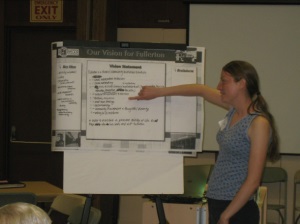
-
Focused Future Visioning Charrettes. Six visioning charrettes were held between June and August 2007. Approximately 105 community members attended one or more of these workshops to share their ideas about the future of their city. During these charrettes, participants were asked to identify Fullerton’s treasures and challenges, as well as their visions for the future of the City. (See Worksheet and Presentation)
-
Youth Visioning Workshops. Four youth visioning workshops were held during the summer of 2007. City staff and the consultant worked with youth participating in different organizations to understand their ideas for the future of Fullerton. (See Worksheet and Presentation)
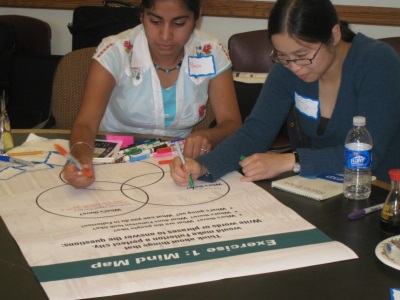
-
Telephone Survey. The Social Science Research Center at Cal State Fullerton assisted the City in obtaining additional input on various topics through a scientific telephone survey in the spring of 2008. Surveys were administered to 475 randomly-selected residents in Spanish and English. A total of 24,023 calls were made to 4,844 unique telephone numbers to complete the Survey. One survey was completed for every 50.57 dial attempts. Six or more call attempts were required to complete one quarter of the interviews. This persistence paid off in an estimated response rate of 66.6 percent, a good outcome for a random digit dial survey of this type in an urban area. Survey respondents were asked up to 94 questions to assess the most valued aspects of the city, perceptions regarding its challenges and problems, satisfaction with city services, the perceived importance of and satisfaction with a variety of city attributes, the perceived contribution of these attributes to the quality of life, and basic demographic information. The telephone survey allowed for input by people who were not necessarily participating in the in-person workshops and meetings. City staff found having a scientific telephone survey to be very beneficial because it validated much what was being heard from the community throughout the initial visioning process. (See Phone Survey Report)
-
Online Survey. An online survey was accessible from the General Plan Update website. The survey garnered input from those who were unable to attend the Visioning Workshop and Open House. It asked participants to list Fullerton’s treasures and challenges, and their visions for the future. The online survey was not as successful as the phone survey due to a low participation rate. Planners now believe the online survey should have been promoted more to receive higher turnout.
-
Roadshow Presentations. Presentations were made to a number of community groups and organizations, including the Rotary Club, the Chamber of Commerce and Fullerton Collaborative.
-
Commission and Committee Meetings. Presentations were made to key City Committees and Commissions including the Parks and Recreation Commission, the Transportation and Circulation Commission, the Sports Field Users' Committee and the Bicycle Users' Subcommittee to encourage the contribution of more ideas to the Visioning process.
-
Visioning Open House. In August 2007, a Visioning Open House was held to show the community the results of the Visioning Charrettes and to receive further input from the community. (See Open House Guide)
-
Neighborhood Meetings. Fifteen presentations and meetings were held between October 2007 and November 2007 to engage community residents in expressing the issues, concerns and ideas that are important to their neighborhood. Meetings were held in different venues throughout the City.
-
Land Use Futures Open House. In October 2008, community members participated in an open house to review the draft Focus Areas. Community members commented on the boundaries of the Focus Areas and identified additional areas for consideration. (See Guide and Flyer)
-
Planning Commission Meeting. The Planning Commission reviewed and recommended The Fullerton Vision and Focus Areas for approval in January 2009.
-
City Council Meeting. The City Council reviewed and approved The Fullerton Vision and Focus Areas in February 2009.
Phase III - The Fullerton Plan Development
-
City Council Meetings. The City Council reviewed and approved the outline for The Fullerton Plan in August 2009.
-
Commission and Committee Meetings. During the months of September and October 2011, the following Commissions, Committees, and Boards reviewed the portions of a working draft of the Public Review Draft relevant to the role of each group:
-
Bicycle Users Subcommittee
-
Citizens’ Infrastructure Review Committee
-
Energy and Resource Management Committee
-
Fullerton Museum Center Board
-
Library Board
-
Parks and Recreation Commission
-
Redevelopment Design Review Committee
-
Technology Working Group
-
Transportation and Circulation Commission
-
-
Planning Commission Meeting. The Planning Commission reviewed and recommended adoption of The Fullerton Plan in its entirety on April 25, 2012.
-
City Council Meeting. The Fullerton Plan was adopted by the City Council on May 1, 2012.
The City maintained a dedicated webpage for The Fullerton Plan, with a link appearing on the City’s homepage for the much of the project. The City also outreached to community members through mailers, flyers, cable channel ads, and articles in local newsletters.
Other City/County Dept. Involvement
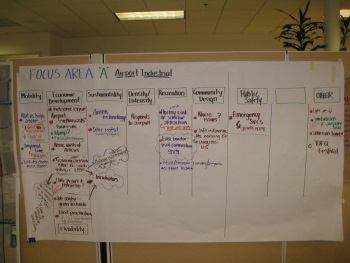
In order to ensure The Fullerton Plan is not just a plan that sits on the shelf and is embraced by all City departments, all departments were involved in policy development and review. An initial Staff Summit was held with the department managers to review the pervious General Plan goals and policies and identify areas that needed to be expanded or changed. A second Staff Summit convened key staff whose work is affected by land use policy to specifically craft the visions and guidance for the Focus Areas and community development types. Many staff outside of the Community Development Department participated in drafting the policies and actions relevant to their work. Each department reviewed and commented on sections of the draft document most pertinent to them.
Legal/Policy Context
The Fullerton Plan meets all of the requirements of California Planning law. The Fullerton Plan was developed as a comprehensive update of the City’s General Plan, which was last updated in 1995.
Consideration of Regional Issues
The Southern California Association of Governments began developing its Regional Transportation Plan and Sustainable Communities Strategy about mid-way through the development of The Fullerton Plan. The land use guidance included in The Fullerton Plan and the anticipated growth cleared through the associated Program EIR fed into the projections used in the Orange County Sustainable Communities Strategy which rolled up into the regional Sustainable Communities Strategy.
Community Reaction to Plan
Community reaction to The Fullerton Plan has generally been positive. The Plan received letters of support from the Southern California Association of Governments, the Building Industry Association, and the Sierra Club, illustrating the wide range of issues addressed in The Fullerton Plan that were important to the community and stakeholders.
Implementation Features
See the “Focus on Implementation and Usability” tab.
Connection to Jurisdictional Budget
The City’s annual budget process is directly tied to The Fullerton Plan and is the second step in the Implementation Process outlined in The Fullerton Plan. Based on the direction of the City Council’s annual priority setting, each department will determine necessary work programs and specific resource needs. These will be incorporated in the City’s budgeting and Capital Improvement Planning process through development of departmental goals and programs and allocation of necessary resources. As part of the budget adoption, the City Council will adopt by resolution the Short-Term Action Plan to implement The Fullerton Plan.
Adaptability
The City recognized the need to be able to adapt The Fullerton Plan over time as priorities and needs change in the City and strived to ensure that the plan does not become out of date quickly. The Fullerton Implementation Strategy includes formal evaluation of The Plan every two years, with intermediary review steps. While many General Plans list actions to implement the policy program over 10 to 20 years, The Fullerton Plan only identifies actions to be completed within 3 to 5 years. Subsequent action plans will be established through the City Council priority setting process. This exercise forces the City to carefully consider and commit to only those actions most appropriate for the time and that can reasonably be accomplished.
Accessibility
The Fullerton Plan layout is deliberately intended to be appealing to the user and easy to navigate. The Fullerton Plan begins with a User’s Guide – an 11x17 simple chart where the user can find his or her role at the top (i.e. City staff, property owner, elected/appointed official, etc.). Below each role the User’s Guide describes the sections most relevant to the user and guides him/her in some basic steps to using the document. This User’s Guide helps orient the new user, and also reinforces the role of each person in implementing The Fullerton Plan. In the electronic (online and on CD) versions of the document, hyperlinks are provided between sections and to outside resources. See the “Focus on Implementation and Usability” tab.
Graphics/Presentation Quality

Great care was taken to make The Fullerton Plan visually appealing and user-friendly. Graphics are only used in The Fullerton Plan when needed to further explain an idea or support the text. Extraneous photos were eliminated to reduce the size of the document and visual clutter.
For ease of navigation, each Master Element is represented by a symbol and one of four colors. Each page within the Master Element uses the Master Element’s color in the headings, text boxes, tables and footer. The corresponding symbol also appears in the header. Clean lines and consistent use of colors are important features of the exhibits as well.
Organization
The organization of The Fullerton Plan directly reflects The Fullerton Vision. While The Plan includes the state-mandated components of a General Plan, it is organized in a manner that is logically consistent with the community’s vision. Several optional Elements or components of Elements were added, including a historic preservation, economic development, public health, bicycle, community involvement, and climate change. The Fullerton Plan is organized into four Master Elements - The Fullerton Built Environment, The Fullerton Economy, The Fullerton Community and The Fullerton Natural Environment. Each Master Element contains Sub-Elements or Chapters as follows:
The Fullerton Built Environment
-
Chapter 1: Community Development & Design
-
Chapter 2: Housing
-
Chapter 3: Historic Preservation
-
Chapter 4: Mobility
-
Chapter 5: Bicycle
-
Chapter 6: Growth Management
-
Chapter 7: Noise
The Fullerton Economy
-
Chapter 8: Economic Development
-
Chapter 9: Revitalization
The Fullerton Community
-
Chapter 10: Public Safety
-
Chapter 11: Public Health
-
Chapter 12: Parks and Recreation
-
Chapter 13: Arts and Culture
-
Chapter 14: Education
-
Chapter 15: Community Involvement
The Fullerton Natural Environment
-
Chapter 16: Water
-
Chapter 17: Air Quality and Climate Change
-
Chapter 18: Integrated Waste Management
-
Chapter 19: Open Space and Natural Resources
-
Chapter 20: Natural Hazards
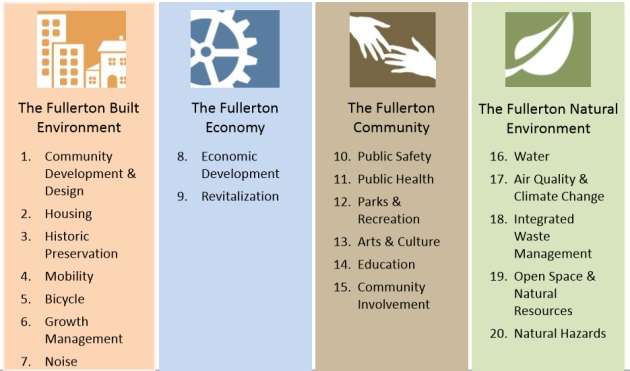
Costs (Expected and Actual)
The original consultant contract was for approximately $983,000. As the project developed, new work products were added to the scope to help further develop The Fullerton Plan and prepare for implementation. These included the update of the Housing Element, a Climate Action Plan, and a Bicycle Master Plan. After requests for additional work, the total consultant fee was approximately $1,307,000.
Costs for in-house work were not tracked.
Adoption Process
Following the public review period, the Planning Commission held one public hearing on The Fullerton Plan and recommended adoption to the City Council. The City Council held one public hearing on The Plan and unanimously voted to adopt The Fullerton Plan without changes.
CEQA Review
A Program Environmental Impact Report was prepared for The Fullerton Plan in accordance with the California Environmental Quality Act.
Legal Challenges
There have been no legal challenges to date. City staff communicated with the State Attorney General’s office and the Office of Planning and Research throughout The Fullerton Plan development to address any concerns early on and provide for a smooth adoption process.
Planning Staff/Consultants
Key City Staff include:
-
Al Zelinka, FAICP, Community Development Director (former)
-
Heather Allen, AICP, Planning Manager
-
Bob St. Paul, Senior Planner
-
John Godlewski, Community Development Director, Retired
Consultant Team:
-
RBF Consulting
-
Kimley-Horn and Associates (Traffic)
-
Stanley R. Hoffman Associates (Economic Analysis)
-
Ryan Snyder and Associates (Bicycle Master Plan)
-
Albert Grover and Associates (City Consultant Traffic Engineer)
Accessing the Plan
The Fullerton Plan is intended to be viewed and used electronically and also in print format. It is available online at http://www.ci.fullerton.ca.us/depts/dev_serv/general_plan_update/default.asp. Electronic copies on CD and print copies are found at City Hall. Both the electronic copies online and on CD contain interactive links between chapters, sections, and to outside resources.
Name of Preparers of this Model
Michelle Lieberman, AICP, AIA, LEED AP, Senior Associate, RBF Consulting
Name of Primary Point of Contact at the Jurisdiction
Heather Allen, AICP, Planning Manager
Date Reviewed by the Jurisdiction
March 14, 2013
CPR Peer Reviewers
Linda Dalton
Al Zelinka
David Booher
CPR Project Team
Elaine Costello, Project Manager; Co-Chairs Cathy Creswell and Janet Ruggiero; Alexis Mena, Project Assistant
The Catalog
Our catalog contains a number of General Plan "Great Model" examples. Browse the entire catalog
Browse by Principle
- Create a Vision
- Manage Change
- Make Life Better
- Build Community Identity
- Promote Social Equity and Economic Prosperity
- Steward and Enhance the Environment
- Engage the Whole Community
- Look Beyond Local Boundaries
- Prioritize Action
- Be Universally Attainable
Browse by tag:
awards city climate-change context county equity graphics growth-management health implementation infill mature-community organization participation preservation redevelopment region rural smart-growth suburban sustainability town urban urban-design web-strategies
